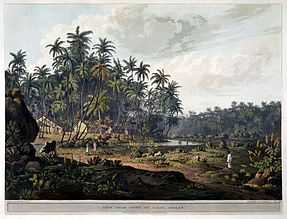Henry Salt (Egyptologist)
.JPG)
Henry Salt (14 June 1780 – 30 October 1827) was an English artist, traveller, collector of antiquities, diplomat, and Egyptologist.
Biography
Salt, the son of a physician, was born in Lichfield on 14 June 1780. He trained as a portrait painter, first in Lichfield and then in London under Joseph Farington and John Hoppner. In 1802 he was appointed secretary and draughtsman to George Annesley, Viscount Valentia. They started on an eastern tour, traveling to India via the Cape Colony. Salt explored the Red Sea area, and in 1805 visited the Ethiopian highlands. He returned to England on 26 October 1806. Salt's paintings from the trip were used to Valentia's Voyages and Travels to India, published in 1809. The originals of all the drawings were kept by Valentia, as also the copper plates after Salt's death. The format and style of the plates is similar to Thomas and William Daniell's work, "Oriental Scenery" (1795-1808).
Salt returned to Ethiopia in 1809 on a government mission to explore trade and diplomatic links with the Tigrayan warlord Ras Wolde Selassie. On his return he published A voyage to Abyssinia, and travels into the interior of that country, executed under the orders of the British government in the years 1809 & 1810, and a collection of drawings entitled Twenty-four Views Taken in St Helena, The Cape, India, Ceylon, Abyssinia and Egypt. He later returned and continued a friendship with the Ethiopian warlord Sabagadis.
In 1815 Salt was appointed British consul-general in Cairo.[1] During his time in Egypt he accumulated a collection of Egyptian artifacts, notably the head of Ramesses II from the Ramesseum, which he presented to the British Museum, and the sarcophagus box of Ramesses III which was bought by the Louvre in Paris. He also sponsored the excavations of Thebes and Abu Simbel, carrying out significant archaeological research himself at the pyramids of Giza and the Sphinx, and earned praise for his ability to decipher hieroglyphs from Jean-François Champollion. In 1825 Mr. Salt published at his own expense Essay on Dr. Young's and M. Champollion's System of Hieroglyphics; with some additional discoveries, by which it may be applied to decipher the names of the ancient kings of Egypt and Ethiopia.
He devoted himself to the task of assembling a collection of antiquities, although he was hindered in every possible way by Bernardino Drovetti, who, having been dismissed from his official post, now had the time personally to supervise the search of antiquities around the country. Drovetti had great advantages over his British rival because of his thorough knowledge of Egypt, where he had been living for many years by this time, and also thanks to his close friendship with the Pasha, Muhammad Ali of Egypt. But Salt was not easily discouraged and resorting to the same methods as his rival, he surrounded himself with agents who would not stop for anything. The year he arrived in Cairo he had the good fortune to meet both Giovanni Battista Belzoni, an extraordinary individual who immediately became his main agent, and Giovanni D’Athanasi, a Greek known as Yanni, who worked for him in the Thebes area from 1817 to 1827. Thanks to his assistants, Salt was able to build up his important collection in just two years. This was sold to the British Museum for the sum of two thousand pounds, and was then followed by another, more important, collection, accumulated between 1819 and 1824, comprising no fewer than 4,014 objects. After being rejected by the British Museum because it was considered too expensive, this second collection was sold to Charles X of France for ten thousand pounds, and helped to enlarge the impressive collections of the Louvre.
Salt also managed to assemble a third collection, containing 1,083 objects. It was sold by auction, largely to the British Museum, in 1835, eight years after his death near Alexandria in 1827.
In popular culture
Salt was portrayed by Robert Portal in the 2005 BBC docudrama Egypt.
Gallery
   |
References
| Wikimedia Commons has media related to Henry Salt (Egyptologist). |
| Wikispecies has information related to: Henry Salt |
- General
- Philosophy of Science Portal
- An excellent account of Salt and his trials and tribulations collecting antiquities in Egypt is in Maya Jasanoff, Edge of Empire: Conquest and Collecting in the East, 1750-1850, Knopf, 2005
- Manley, Deborah; Rée, Peta (2001). Henry Salt: Artist, Traveller, Diplomat, Egyptologist. London: Libri. ISBN 978-1-901965-04-9. OCLC 48506350.
- Goldschmidt, Arthur (2000). Biographical Dictionary of Modern Egypt. Boulder, CO: Lynne Rienner Publishers. p. 180. ISBN 978-1-55587-229-8. OCLC 52401049.
- "Henry Salt". British Museum. Retrieved 2009-06-26.
- Specific
| Diplomatic posts | ||
|---|---|---|
| Preceded by Edward Missett |
British Consul-General in Egypt 1815–1827 |
Succeeded by John Barker |
|